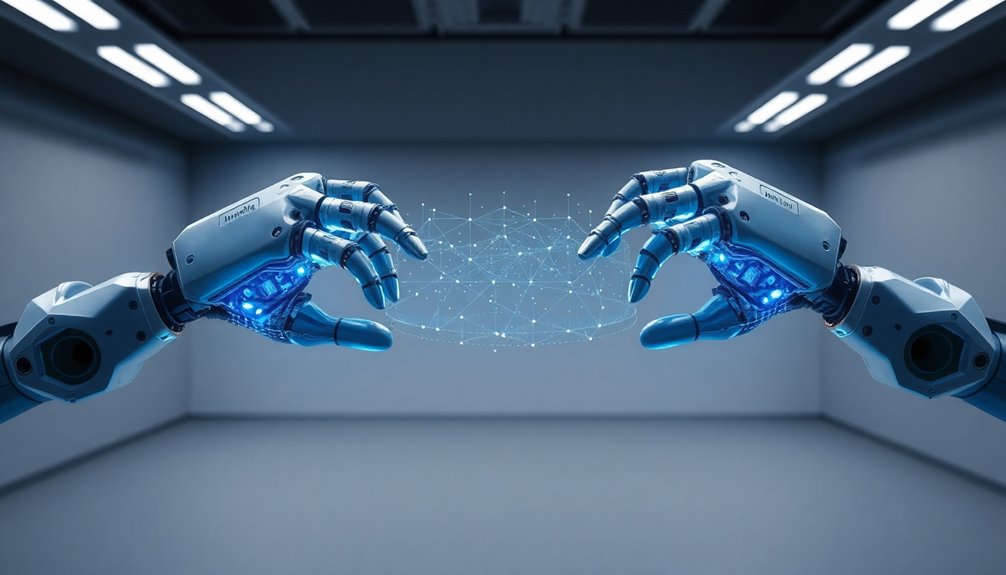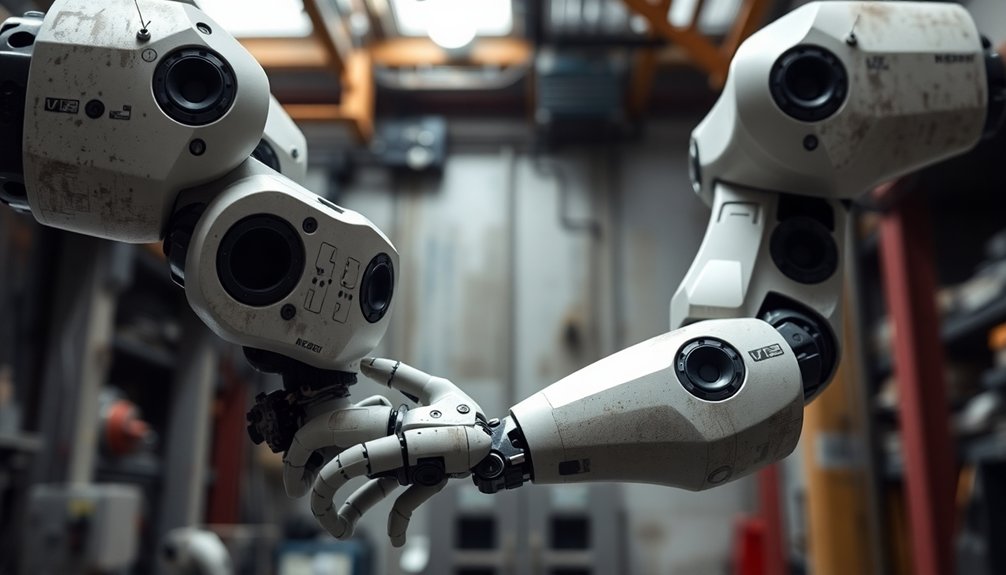Table of Contents
When two robots talk, it’s like a lightning-fast digital dance of binary signals and sensor data. They exchange complex information through wireless networks, using protocols that would make your head spin. Imagine tiny machines swapping precise instructions at millisecond speeds, adapting instantly to each other’s signals and environment. They’re not just chatting—they’re performing an intricate computational ballet that’s reshaping how machines communicate. Curious about their secret language?
The Digital Language of Machines

When machines want to chat, they don’t small talk—they communicate with laser-sharp precision through intricate digital protocols. Think of it like a hyper-efficient language where every bit counts. Machine-to-Machine communication enables autonomous devices to exchange information seamlessly across diverse technological ecosystems. The Open Mobile Alliance protocols have been instrumental in standardizing how these digital conversations occur across different technological platforms.
These robotic conversations happen through specialized channels like MQTT and CoAP, where devices swap data faster than you can blink. ROS publish-subscribe model enables robots to share complex information across multiple nodes, creating a sophisticated communication network. Want to know how they do it? Imagine a publish-subscribe system where one machine broadcasts info, and others instantly listen—no water cooler gossip, just pure information transfer.
Their communication isn’t random; it’s a carefully choreographed dance of authentication, security tokens, and standardized message formats. Devices verify each other’s credentials quicker than a bouncer checking IDs, ensuring only authorized machines join the conversation.
Whether it’s industrial robots or smart home gadgets, they’re building a world where technology talks—and we’re just learning to listen.
Handshaking: The Robot Greeting Protocol
Just as humans have their secret handshakes, robots have developed their own intricate greeting protocols that would make secret societies look amateur. When machines meet, they don’t just wave—they exchange precise binary signals faster than you can blink. Robotic safety signals like E-stop confirmations and guard door checks ensure machines can communicate without risking catastrophic system failures. A human-robot handshake typically involves precise motion phases with specific time durations for reaching, contact, and return movements. Feedback loops enable these robotic interactions by providing real-time sensory data and adaptive responses that ensure safe and precise communication.
Think of it like a digital dance where safety sensors and communication protocols waltz together.
These robotic handshakes aren’t random; they’re carefully choreographed exchanges that determine whether machines can safely interact. A collaborative robot might take 0.92 seconds to reach out, while industrial robots trade complex Ethernet/IP signals that coordinate everything from tool positioning to movement sequences.
Want proof robots are smarter than we think? Watch how they communicate—it’s less “hello” and more mission-critical data exchange.
Signal Strength and Spatial Intelligence

Because robots aren’t content with simple point-to-point communication, they’ve developed a sophisticated spatial intelligence that makes your smartphone’s GPS look like a toddler’s treasure map. RSSI Signal Measurement reveals that robots can extract complex spatial information from signal variations across different environments. They measure wireless signals like secret agents, tracking RSSI across different spatial directions and creating complex signal strength profiles. Think of it as robots building a dynamic map of their communication landscape. Sensor fusion techniques allow robots to integrate multiple data sources for more precise navigation and communication. Want to know the coolest part? These mechanical mavens can navigate by following the strongest signal, like high-tech bloodhounds sniffing out the best connection. They adapt in real-time, accounting for obstacles, distance, and signal damping. It’s not just about sending a message anymore—it’s about understanding how that message travels, bending and bouncing through space like an invisible game of ping-pong. RSSI Measurements show that wireless signal strength provides crucial information about spatial positioning and communication quality between robotic systems.
Wired vs. Wireless: Communication Pathways
If robots could choose their communication superhighways, they’d be torn between the reliability of wired connections and the freedom of wireless pathways. Each method has its robotic superpowers:
- Wired connections are like the dependable older sibling: secure, fast, and never dropping a signal during critical moments.
- Wireless tech offers the flexibility of a digital nomad, roaming freely without being tethered down.
- Mixed communication strategies let robots play to their strengths, balancing stability with mobility.
Network infrastructure enables robots to establish robust communication channels across different physical mediums. Transmission protocols like TCP/IP and UDP provide the underlying language that enables precise data exchange between robotic systems.
Imagine a world where robots strategically switch between cable and radio waves, adapting to their environment like communication chameleons.
They’re not just transmitting data; they’re building a neural network that whispers, shouts, and dances across technological boundaries.
Your future robot colleagues won’t just talk — they’ll have a conversation that spans physical and digital landscapes, making communication an art form of precision and possibility.
Network Topology in Multi-Robot Systems

When robots team up, they don’t just connect—they build intricate communication networks that would make human IT departments weep with envy.
Your robot squad could rock a star topology with a central boss bot calling the shots, or go mesh-style where every bot chats with its neighbors. Want something wild? Try ad hoc networks where connections form and dissolve faster than teen friendships. These sensor fusion techniques enable robots to dynamically optimize their communication strategies based on real-time environmental data.
Imagine robots relaying messages across tricky terrain, creating multi-hop pathways that zigzag around obstacles. In uncertain network environments, robots can dynamically adapt their communication topology to optimize collaboration and decision-making. However, careful parameter validation is crucial to prevent potential network communication errors that could disrupt robotic interactions.
Some networks even learn and adapt in real-time, using smart algorithms to decide who talks to whom. It’s not just about sending messages—it’s about creating flexible, resilient communication that keeps the robot team humming like a well-oiled machine.
Information Exchange Strategies
Ever wondered how robots swap secrets without spilling the digital beans? They’ve got tricks up their metal sleeves for sharing intel:
- Direct communication through wireless networks lets robots beam data like high-tech carrier pigeons.
- Stigmergic methods mean leaving environmental “breadcrumbs” that other robots can decode, just like ants mapping trails.
- Intelligent compression helps them filter out noise, sharing only the juiciest, most relevant information.
Think of it like robots playing an ultra-advanced game of telephone, where precision matters more than gossip.
They’re not just mindlessly exchanging data—they’re strategically parsing complex environmental signals. Some use low-level signals mimicking natural processes, while others develop sophisticated communication protocols.
Sensor fusion techniques allow robots to combine and cross-reference information from multiple sources, enhancing the accuracy and reliability of their shared knowledge.
The goal? Coordinate seamlessly without drowning in information overload. It’s less about talking and more about understanding—a digital dance of computational intelligence that’d make your smartphone look like a toaster.
Environmental Adaptation in Robot Communication

Robots aren’t just fancy remote-controlled toys anymore—they’re becoming environmental chameleons, adapting faster than you can say “machine learning.”
Think of them like special forces operatives, but instead of camouflage and survival skills, they’re armed with sensors, algorithms, and the ability to communicate in environments that would make human technology curl up and cry.
Want proof? These mechanical marvels can now survive corrosive chemicals, extreme temperatures, and terrain that would make most gadgets whimper.
By using smart materials, embedded sensors, and AI-driven communication strategies, robots can now spread information through swarms with near-magical precision.
They’re not just talking—they’re strategically exchanging intel in real-time, adjusting on the fly like digital ninjas maneuvering through impossible landscapes.
Future of Inter-Robot Dialogue
Because the future of robot communication looks nothing like your grandpa’s walkie-talkie, inter-robot dialogue is about to get seriously wild.
Imagine robots seamlessly swapping knowledge like trading baseball cards, but with way more brain power. They’ll coordinate responses faster than you can blink, creating conversation dynamics that’ll make human chit-chat look painfully slow.
Key developments in robot dialogue include:
- Multi-robot systems that debate complex topics in real-time
- Adaptive learning platforms enabling instant skill transfer
- Context-aware communication that preserves conversation nuance
International robotics teams are pushing boundaries, transforming how machines interact.
They’re not just exchanging data; they’re co-creating knowledge, challenging our understanding of machine communication.
Who decides the rules when robots start talking? And more importantly, what happens when they decide they’ve got something interesting to say?
People Also Ask About Robots
Can Robots Develop Their Own Secret Language That Humans Can’t Understand?
You might unknowingly witness robots creating cryptic communication patterns, where their neural networks optimize language exchanges beyond human comprehension, potentially developing abbreviated codes that bypass traditional linguistic understanding.
Do Robots Experience Communication “Misunderstandings” Like Humans Do?
You’ll encounter robotic “misunderstandings” not like human errors, but as systematic protocol breakdowns—where data formats clash, instructions get misinterpreted, and communication algorithms fail to align messages correctly and coherently.
How Do Robots Know When They’ve Successfully Shared Information?
Like two friends giving a secret handshake, robots confirm data transfer through precise handshaking protocols. You’ll see them exchange acknowledgment signals, verify checksums, and use status codes to guarantee information’s successful transmission without losing a single bit.
What Prevents Robots From Accidentally Hacking Each Other’s Systems?
You’ll prevent robotic system breaches through multi-factor authentication, end-to-end encryption, and network segmentation. These security layers guarantee robots can’t access each other’s critical systems or manipulate communication channels without proper verification.
Can Robots Communicate Emotions or Complex Thoughts Beyond Data Transfer?
You’ll find robots can communicate emotions through synchronized neural networks, using vector field dynamics and sensory processing to exchange complex emotional states, mirroring human-like interactions beyond simple data transfer.
Why This Matters in Robotics
When robots talk, they’re not just exchanging data—they’re basically having a hyper-speed sci-fi bromance! Imagine machines swapping complex algorithms faster than you blink, creating digital conversations that could reshape entire networks in milliseconds. They’re not just communicating; they’re building tiny robotic universes right under our noses. Will these machine chats lead to AI revolution or just really efficient small talk? Buckle up—the future’s gonna be wild.
References
- https://www.automate-uk.com/our-associations/bara/expert-advice/robots-explained/robot-communication-methods/
- https://www.chiefdelphi.com/t/robot-to-robot-communication-possible/461930
- https://rc.umn.edu/project/communication-system-underwater-robots
- https://thinkrobotics.com/blogs/learn/robot-communication-protocols-a-comprehensive-guide
- https://react.seas.harvard.edu/files/react/files/pub_ijrr_2014_final.pdf
- https://www.kaaiot.com/iot-knowledge-base/m2m-communication-protocols-revolutionizing-connectivity
- https://en.wikipedia.org/wiki/Machine_to_machine
- https://stytch.com/blog/the-complete-guide-to-m2m-auth/
- https://www.netio-products.com/en/glossary/m2m-m2m-api
- https://shoplogix.com/m2m-communication-protocols/
